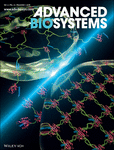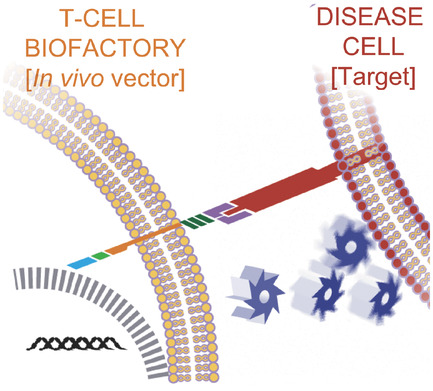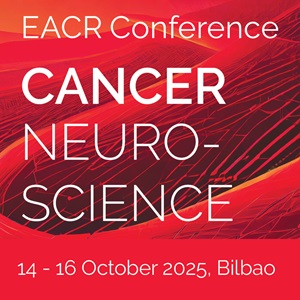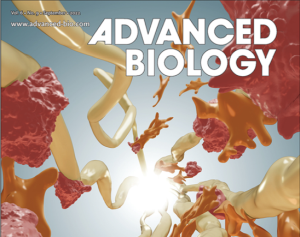Journal list menu
Export Citations
Download PDFs
Cover Picture
Dynamic Biomaterials: Cyclic Stiffness Modulation of Cell-Laden Protein–Polymer Hydrogels in Response to User-Specified Stimuli Including Light (Adv. Biosys. 12/2018)
- First Published: 07 December 2018
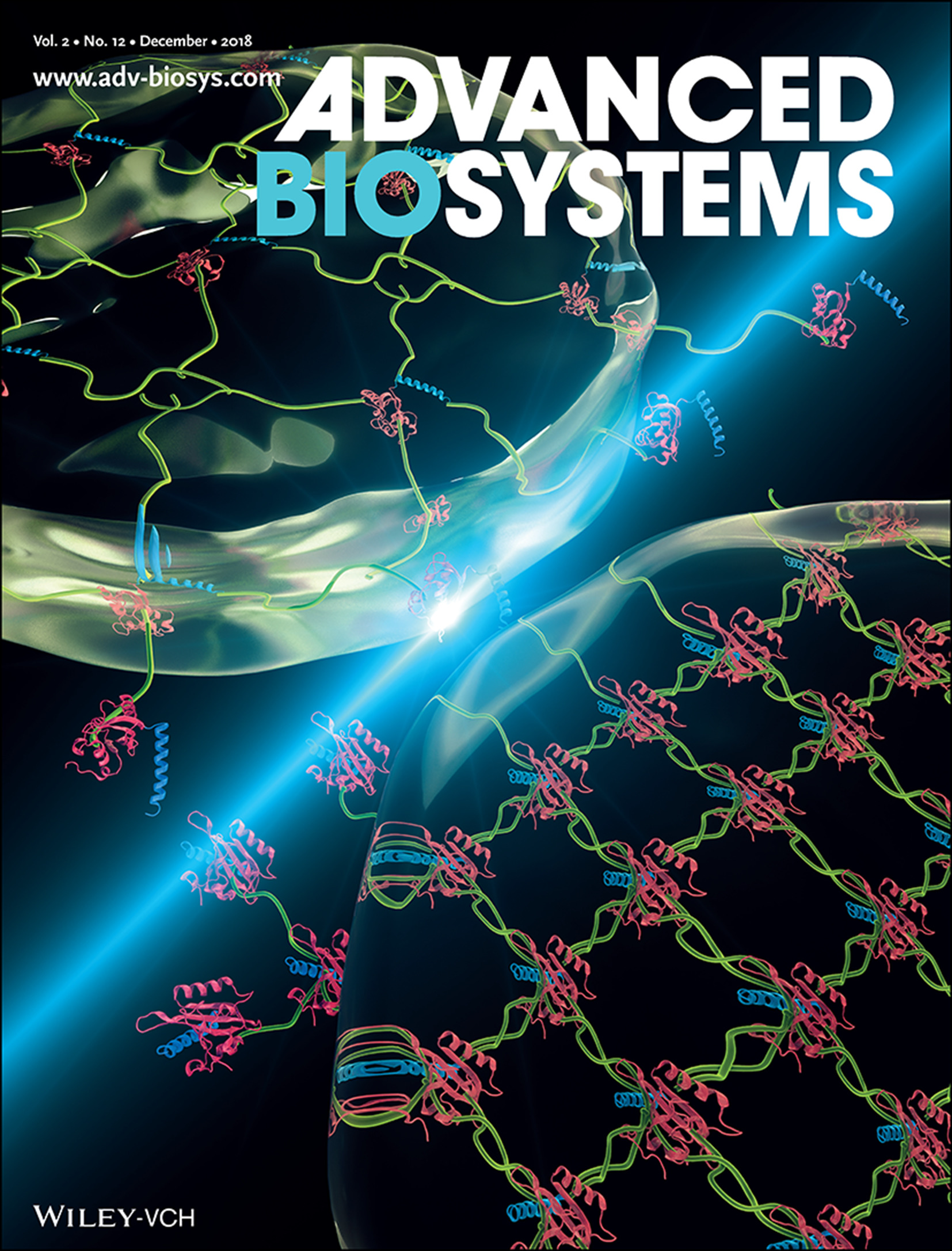
In article number 1800240, Cole A. DeForest and co-workers demonstrate that hydrogel biomaterials crosslinked with stimuli-responsive fusion proteins can undergo fully reversible stiffening upon exposure to user-specified environmental cues. Gels built upon optogenetic proteins LOV2 and Jα soften near-instantaneously under blue light, enabling spatiotemporal control of hydrogel compliance in the presence of living cells.
Inside Front Cover
Silicon Nanowires: Single Silicon Nanowire-Based Fluorescent Sensor for Endogenous Hypochlorite in an Individual Cell (Adv. Biosys. 12/2018)
- First Published: 07 December 2018
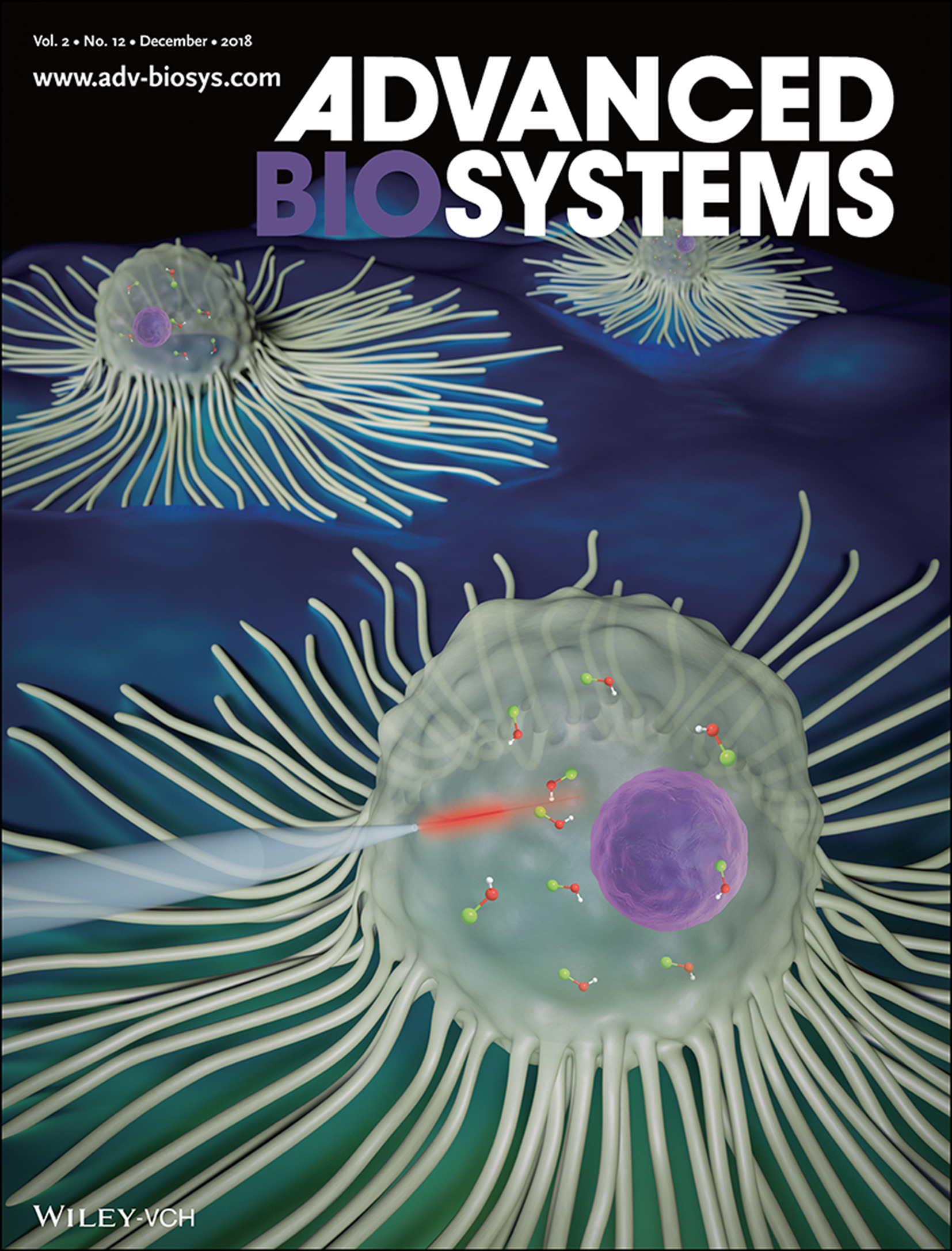
In article number 1800213, Lixuan Mu, Wensheng Shi, and co-workers develop a single silicon nanowire-based fluorescent sensor for endogenous hypochlorite in individual cells. By inserting the functionalized single nanowire into the cell and measuring its fluorescence, the hypochlorite in the cell can be detected. The strategy presented in this work opens a new door to a variety of studies by combining the strengths of single-cell detecting techniques with biology.
Back Cover
Biosystem Assembly: Origami Biosystems: 3D Assembly Methods for Biomedical Applications (Adv. Biosys. 12/2018)
- First Published: 07 December 2018
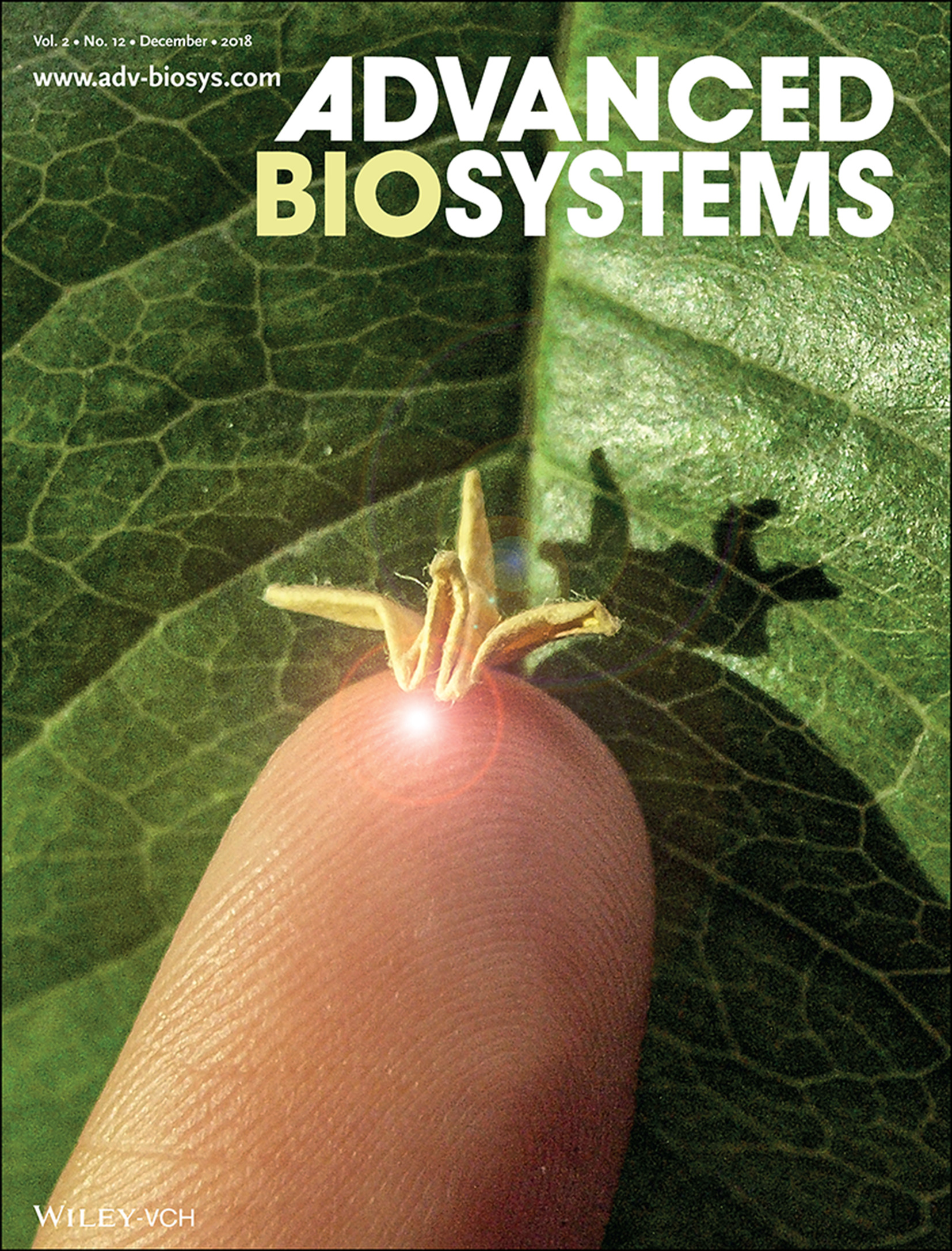
3D assembly methods based on bending, curving and folding are important for the integration of advanced biosystems. In article number 1800230, David H. Gracias and co-workers classify these origami and biologically inspired methods and discuss important advances of relevance to biomolecular systems, sensing, microfluidics, robotics, drug delivery, and cell and tissue engineering.
Masthead
Reviews
Origami Biosystems: 3D Assembly Methods for Biomedical Applications
- First Published: 05 September 2018
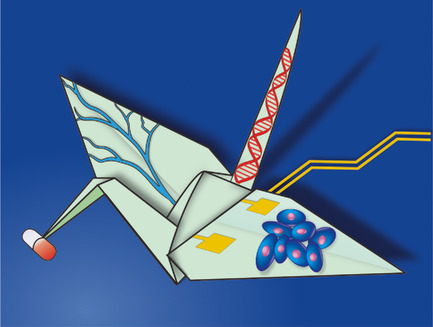
Origami biosystems are an emerging class of integrated, multifunctional devices that are based on curved and folded geometries. In this review, the field is classified into biosystems of relevance to biomolecular assembly, biosensors, biomicrofluidics, cell and tissue engineering, drug delivery, and biorobotics, and relevant advances and challenges are discussed.
Communications
Cyclic Stiffness Modulation of Cell-Laden Protein–Polymer Hydrogels in Response to User-Specified Stimuli Including Light
- First Published: 12 October 2018
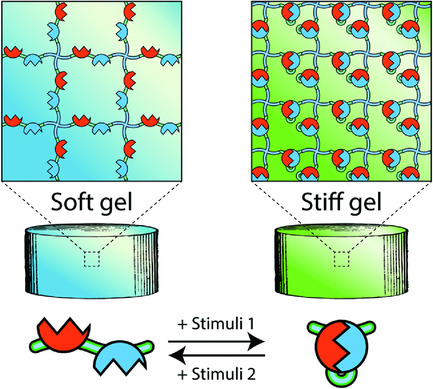
Fusion protein-based gel crosslinkers that exhibit stimuli-dependent intramolecular association yield hydrogel biomaterials that undergo reversible stiffening in response to user-specified inputs. Linkers based on calmodulin yield calcium-sensitive materials, while those containing the photosensitive light, oxygen, and voltage sensing domain 2 (LOV2) protein give cell-laden constructs whose moduli can be cycled with spatiotemporal control.
Full Papers
Single Silicon Nanowire-Based Fluorescent Sensor for Endogenous Hypochlorite in an Individual Cell
- First Published: 09 October 2018
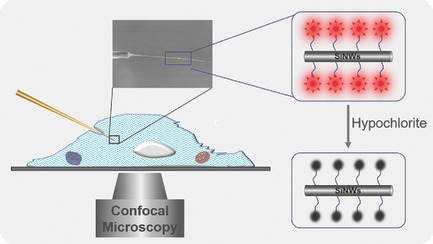
As a paradigm of a single-cell detecting technique, a single silicon nanowire-based fluorescent sensor for endogenous hypochlorite in a macrophage is realized with the help of micromanipulation and confocal microscopy. This work will open a new door to a variety of studies by combining the strengths of single-cell detecting techniques with biology.
Modular Antigen-Specific T-cell Biofactories for Calibrated In Vivo Synthesis of Engineered Proteins
- First Published: 14 September 2018
Exfoliation in Endotoxin-Free Albumin Generates Pristine Graphene with Reduced Inflammatory Properties
- First Published: 17 September 2018
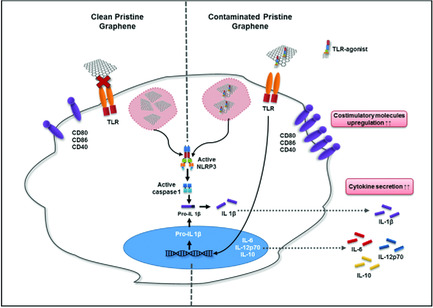
This study reports the production of endotoxin-free bovine serum albumin (BSA)-exfoliated pristine graphene (EF-Gr) and its capacity to modulate immune cell responses. While conventional BSA-exfoliated graphene induces unspecific immunomodulatory responses, the same is not observed with EF-Gr. This suggests that previously reported effects of graphene preparations might have resulted from contaminants and calls for a reassessment in the literature.
Engineering Neural Tissue from Human Pluripotent Stem Cells Using Novel Small Molecule Releasing Microspheres
- First Published: 17 September 2018

Controlled release of the small molecule morphogen purmorphamine from poly ε-caprolactone microspheres is characterized. Then, engineered neural tissues are produced by forming aggregates of human-induced pluripotent stem cells in the presence of drug loaded microspheres. These engineered neural tissues express the motor neuron markers HB9 and ChaT.
Microfluidics-Assisted Fabrication of Microtissues with Tunable Physical Properties for Developing an In Vitro Multiplex Tissue Model
- First Published: 24 September 2018

Macrophage-laden microgels developed with a microfluidic flow-focusing device are used to engineer an in vitro “multiplex” tissue model. Proliferation and Mφ activation of encapsulated macrophages are significantly influenced by microgel mechanics. These macrophage-laden microgels as “microtissues” are embedded in a larger tissue structure, and their interdependency between macrophages and surrounding cells are evaluated.
SERS Nanoprobes in Biologically Raman Silent Region for Tumor Cell Imaging and In Vivo Tumor Spectral Detection in Mice
- First Published: 21 September 2018
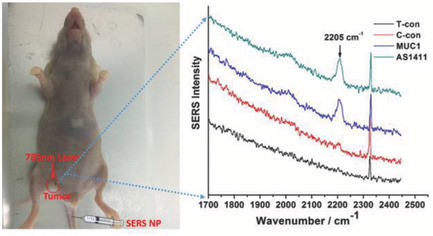
Aptamer (AS1411 and MUC1) charged surface enhanced Raman scattering (SERS) nanoprobes with an alkyne Raman reporter in the biological Raman-silent region (1900–2500 cm−1) are developed. These SERS nanoprobes are successfully used for sensitive detection and imaging of cancer cells and in vivo detection of early stage tumors in mice.
Chip-Based Heat Stimulation for Modulating Signal Propagation in HL-1 Cell Networks
- First Published: 24 September 2018
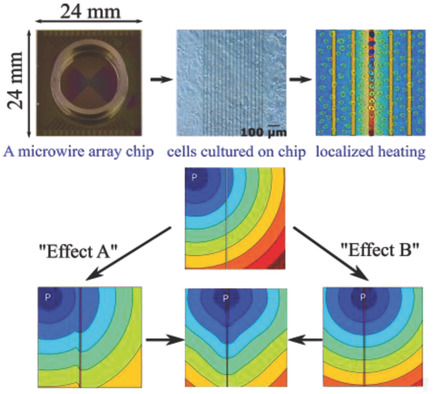
It is demonstrated that local heat stimulation can increase the velocity of Ca2+ waves in cardiomyocyte-like cell networks leading to a deformation of the wavefront. Furthermore, evidence of heat-induced changes in the signal propagation direction possibly caused by a relocation of the pacemaker cell is shown.
Incorporation of Terbium into a Microalga Leads to Magnetotactic Swimmers
- First Published: 24 September 2018
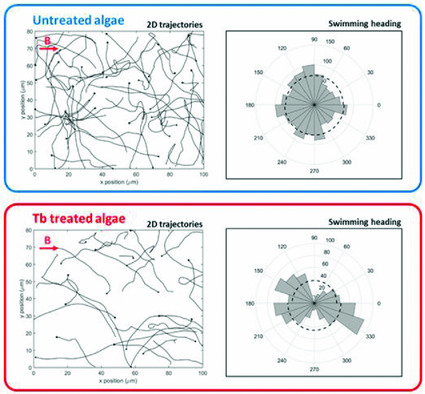
Magnetotactic microalgae are facilely generated by accumulation of magnetic terbium ions inside the living cells. The fast swimming algae can be controlled magnetically, they align passively to magnetic field lines and swim actively towards the magnets. They have fluorescence properties due to the lanthanide terbium and show mutual biocompatibility with mammal cells. The reported magnetotactic microalgae display promising candidates for microrobotic devices.
Profiling Heterogeneous Circulating Tumor Cells (CTC) Populations in Pancreatic Cancer Using a Serial Microfluidic CTC Carpet Chip
- First Published: 26 September 2018
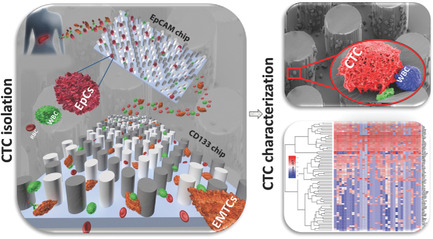
“Carpet Chip” uses sequential immunoaffinity-based microfluidics to study the biological relevance of heterogeneous circulating tumor cell (CTCs). Both epithelial (EpCs) and epithelial-to-mesenchymal transition (EMT)-like CTCs (EMTCs) are detectable from the blood of pancreatic cancer patients. Based on our observations of EMTCs and patient lymph node involvement, individualizing therapies targeting genes involved in EMT could reduce metastasis, thereby improving patient survival.
Targeting Cx26 Expression by Sustained Release of Cx26 Antisense from Scaffolds Reduces Inflammation and Improves Wound Healing
- First Published: 15 October 2018
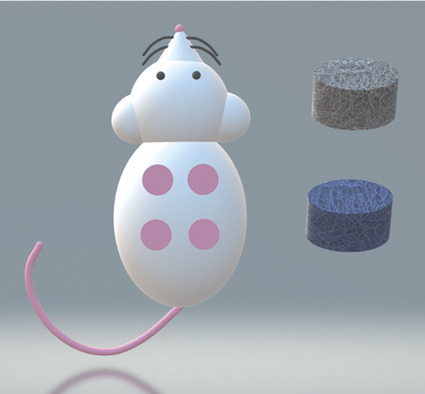
The gap junction protein connexin 26 (Cx26) is expressed at high levels in hyperthickened chronic wound edges. Here, a collagen scaffold implanted into a rat skin wound induces a foreign body reaction, epidermal thickening, elevates Cx26, inflammation, and perturbed healing. Coating scaffolds with Cx26 antisense prevents its upregulation, reduces the foreign body reaction and inflammation, and promotes healing, indicating a potential therapeutic target.
Mechanical Characterization of hiPSC-Derived Cardiac Tissues for Quality Control
- First Published: 24 October 2018
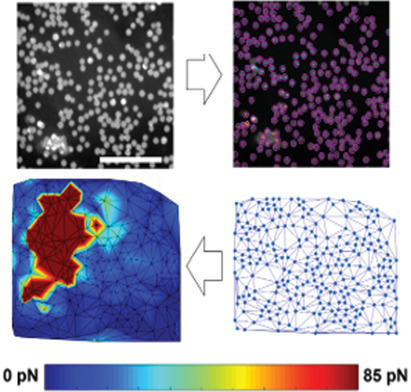
In anticipation of the clinical application of engineered cardiac tissues, a suite of methods combining fluid mechanics, live imaging, and magnetic tweezers is developed to measure the properties critical to cardiac function, including beating frequency, contractile forces, and tissue viscoelasticity. The measured mechanical properties are integrated to compute 3D stresses experienced dynamically by engineered tissue.




